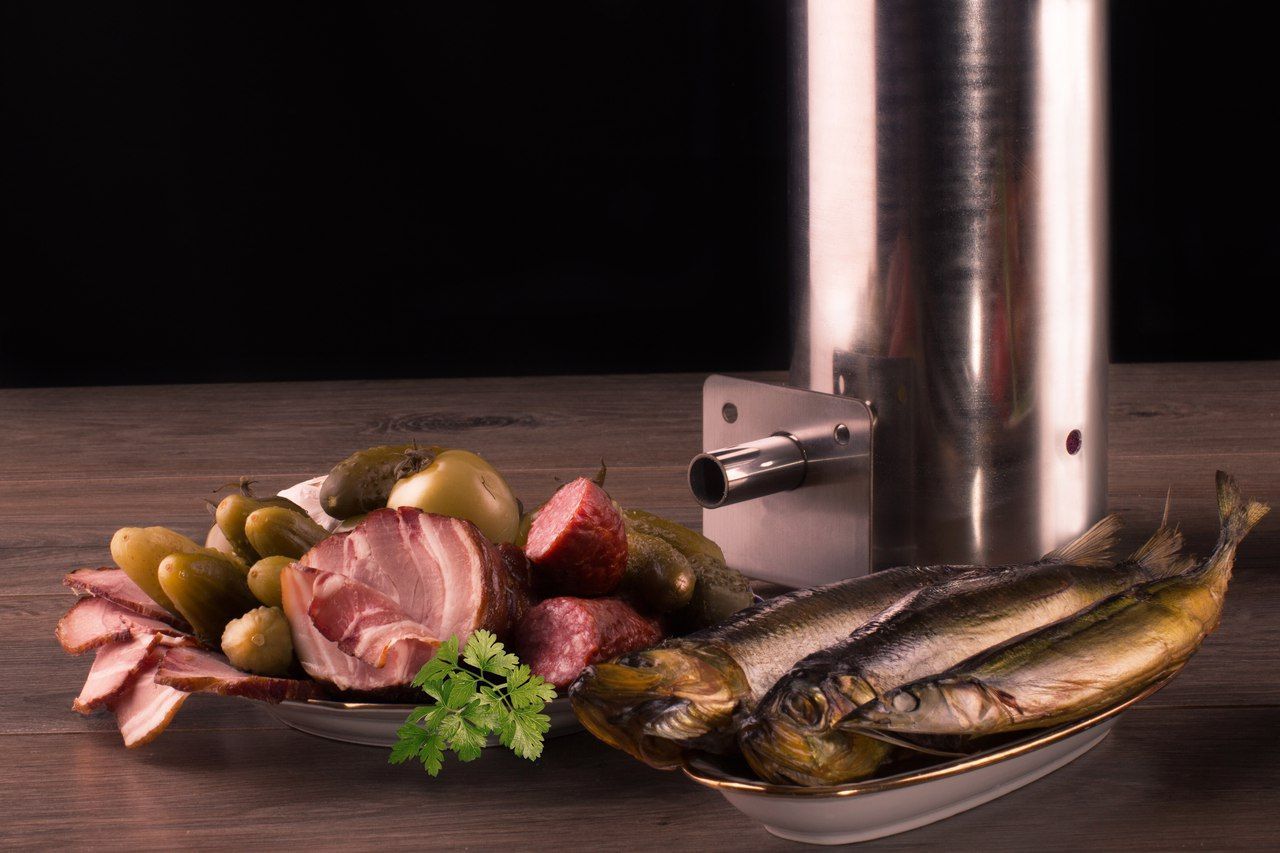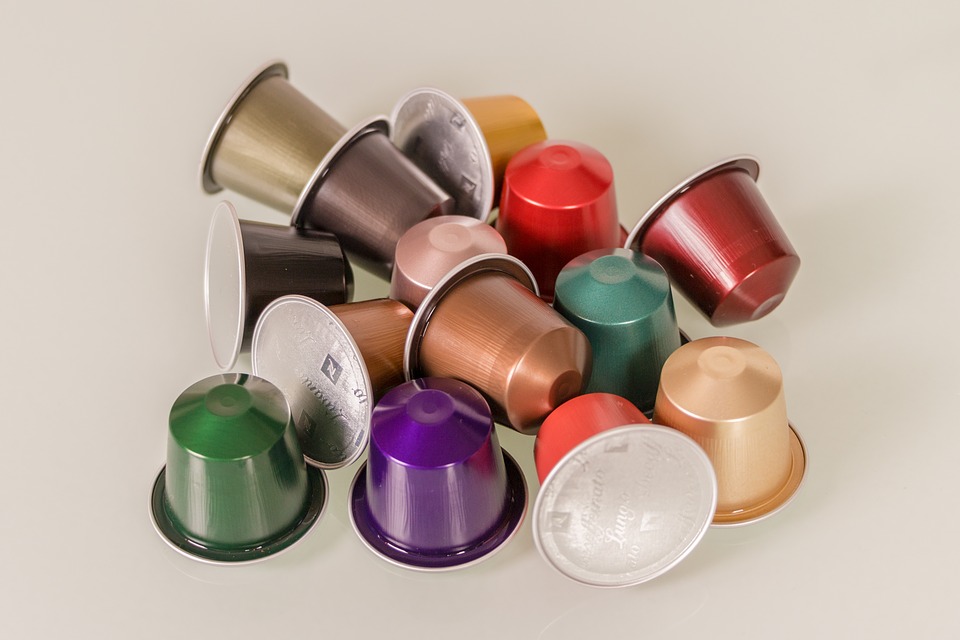Rating of the best powdery mildew remedies for 2020
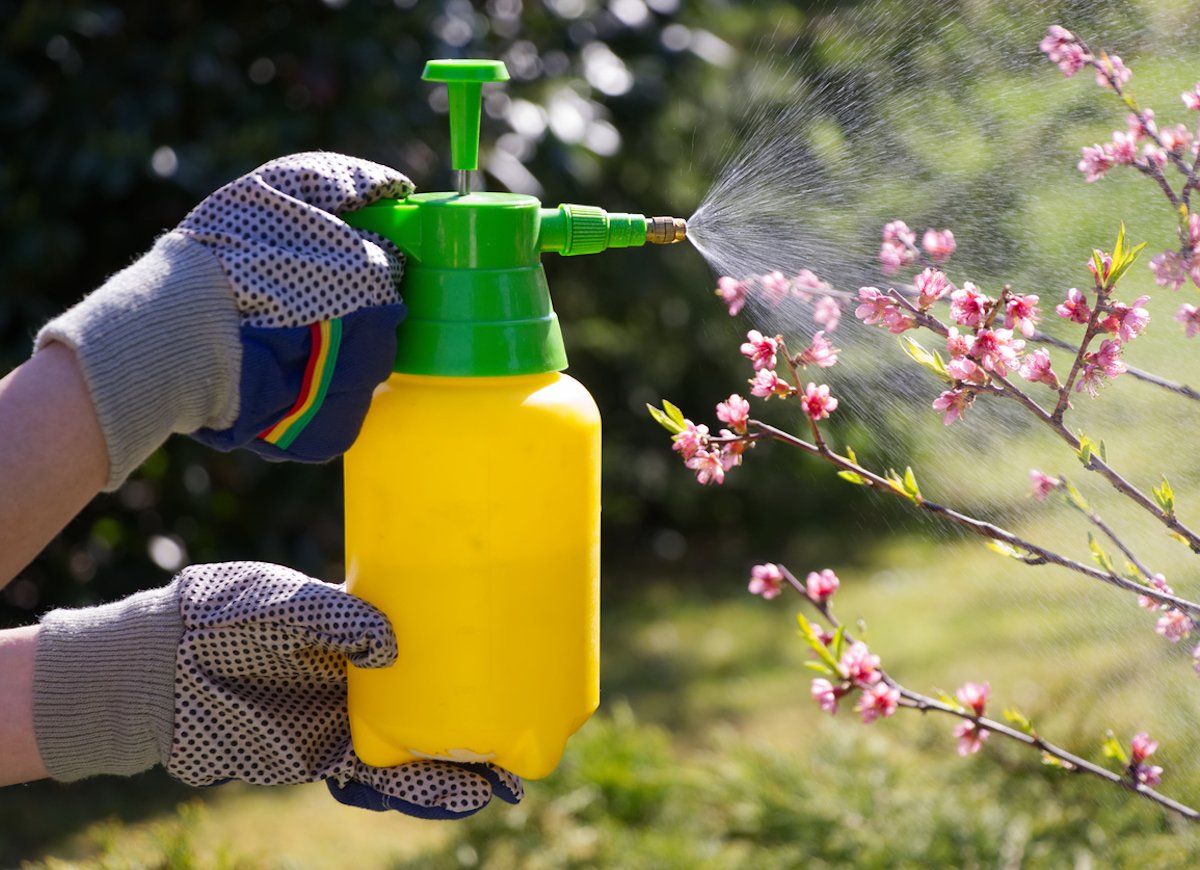
Powdery mildew of ornamental and agricultural crops is a collective term for the various types of pathogenic microorganisms responsible for the development of white flour-like spots on the leaves of infected annual and perennial flowers, trees and shrubs. From the article you can learn about the best fertilizers in the fight against powdery mildew.
Symptoms of the disease, how to identify the disease
Fungi from the Erysiphales group, including Golovinomyces cichoracearum, Erysiphe azaleae, or Podosphaera pannosa, infect a variety of perennials and annuals. The disease damages asters, azaleas, mallow, and other plant species popular and eagerly grown by hobby gardeners.
It is worth knowing that, unlike most fungal infections, powdery mildew does not need rainy, humid weather for intensive development. To protect the garden from them, you need to be vigilant even on sunny, hot days.
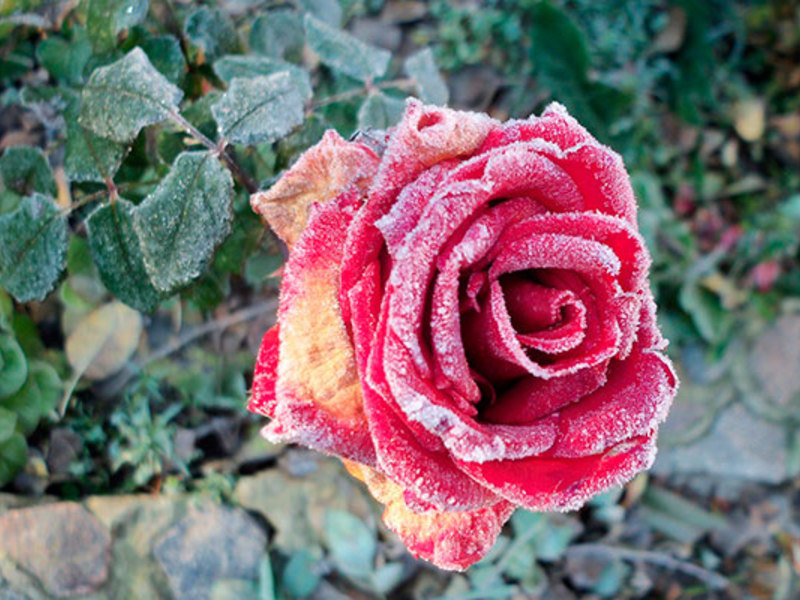
The disease is easy to recognize because it leaves visible traces in the form of a white, flour-like coating on the aerial parts of plants - leaves, stems, buds and fruits.
If you do not fight in a timely manner, then this can lead to:
- drying plants;
- distortion of shoots, leaves and fruits;
- freezing in winter;
- to weaker flowering and fruiting;
- delay in growth and death.
Important! The wind blows dew spores to other plants in the garden, and the white bloom is just the beginning. Over time, if you do not use fungicides, it will darken and begin to form the fruiting bodies of the fungus (similar to black balls). This is a way for mold to infect plants next spring.
A fungus such as powdery mildew not only spreads easily but also infects flowers, fruit trees, shrubs and vegetables. It is important to inspect the plants in the garden and start fighting this disease immediately.
Plants that are often attacked by the disease:
- fruit trees - apple, pear;
- fruit bushes - strawberries, raspberries;
- vegetables - carrots, tomatoes, lettuce, parsley;
- trees - birch, oak, poplar, maple, willow;
- shrubs - roses, hydrangeas, viburnum, lilac;
- lianas - ivy, honeysuckle;
- flowers - asters, dahlias, yarrow, carnations, marigolds, peonies, violets, chamomile, rudbeckia.
Important! The disease affects lawns and even appears on weeds (goldenrod, plantain).
Where and how does powdery mildew occur?
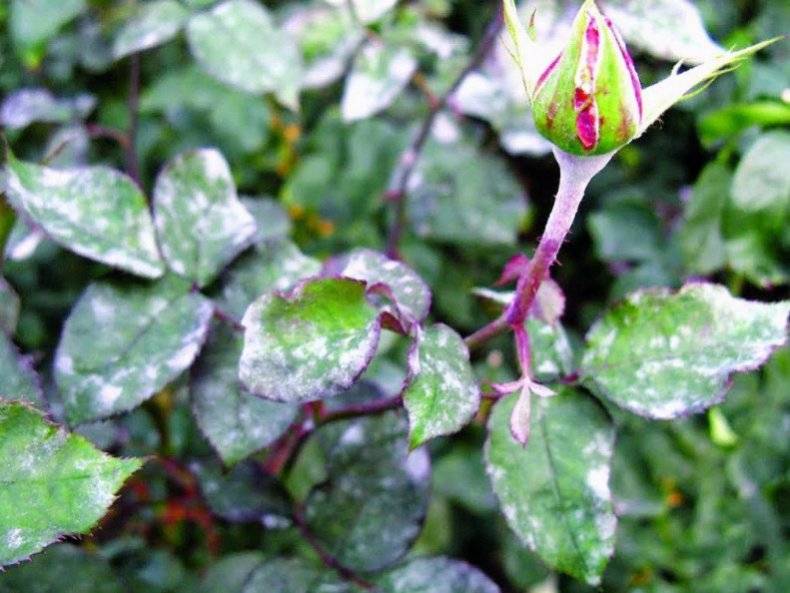
Mycelium overwinters in buds, on shoots and fallen leaves around. In spring, spores are formed that affect leaves, less often shoots or flowers, become infected at low humidity, when there is a large temperature difference between day and night. A white powdery coating is visible on the affected areas. The disease spreads quickly; low temperatures and prolonged rainfall do not stop him.
Spores overwintering in fallen leaves and shoots infect the leaves in spring and then move to stems and fruits. Light green or light yellow spots appear on the upper side of the leaves, and a slight white, gray, or purple coating is visible on the lower side of the leaves. In conditions of high humidity, the disease develops rapidly, and new infections occur within 3-5 days. The infected parts die quickly.
In different cultures, the disease manifests itself in different ways. A mealy bloom is visible on young leaves of the apple tree, and red on the fruits. In gooseberries and currants, the disease manifests itself at the ends of the shoots in the form of a white bloom. In peaches, it appears on the lower part of the leaves and the tops of the shoots. Strawberries, when affected by powdery mildew, have a gray coating on the underside of the leaves. Sick leaves die.
Symptoms of flower disease
The disease affects all parts of the flowers, but most easily manifests itself on the upper side of the leaves as yellow, brown, or purple spots. A delicate white or purple coating can be seen on their underside in wet weather, as a result of which the leaves die. Most susceptible to damage: geranium, pansies, buttercup, poppy, anemone, chrysanthemum.
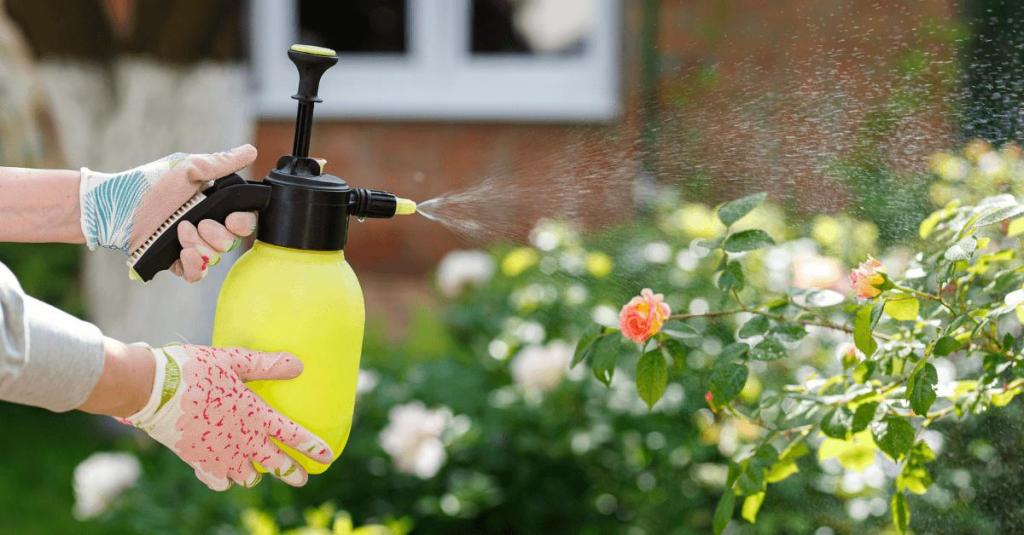
Flowers susceptible to mold:
- asters;
- begonia;
- zinnias;
- dahlia;
- buttercup;
- Violet;
- phlox;
- lupine;
- larkspur;
- rudbekia;
- astilb;
- anemone;
Prevention is better than cure
Effectively removing powdery mildew from the garden is possible with fungicides and preventive spraying is key here.
Powdery powdery mildew and downy mildew are fungal diseases that are common and infect a very wide range of plants: from those growing in greenhouses, fields, gardens, to potted (indoor) plants grown at home. And as it was said earlier, these mushrooms do not pass even ordinary weeds.
Important! Preventive measures will help protect the garden and vegetable garden from the scourge of this disease, so it would be wrong to ignore them.
Useful Tips
- when creating a new crop, choose varieties resistant to various kinds of fungal diseases;
- avoid over-feeding, especially nitrogen fertilizers;
- pay attention to the distance between bushes, trees providing access to light and air;
- protect the leaves from moisture, water the plants only from below, preferably in the morning or evening;
- remove weeds from crops, they are often inhabited by fungi that spread crops;
- use horsetail preparations to strengthen. Strengthening the cells and structure of the leaves makes it difficult for fungal spores to penetrate;
- If you notice the signs of powdery mildew, you must immediately remove the leaves and flowers and burn them.
Home remedies to combat powdery mildew
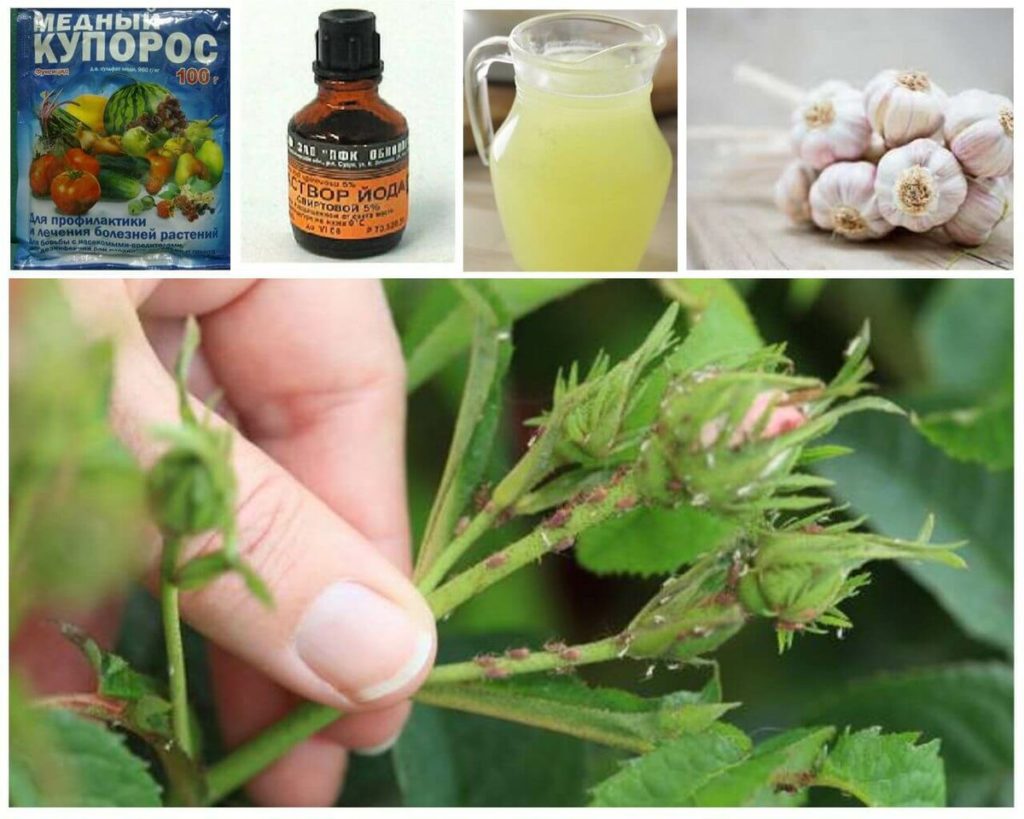
- Cutting off powdery mildew. This is the first and necessary action in the fight against powdery mildew. The removed leaves are best burned to prevent further spread of the fungus.
- Milk and whey. You must mix a liter of skim milk with 4 liters of warm water. The resulting solution is sprayed on the plants under control every other day for two weeks. The soil around the plants is also sprayed.
- Baking powder. For 5 liters of warm water, you need to take 3 bags of baking powder, 3 tablespoons of rapeseed oil and 3 drops of dishwashing liquid. Sick plants are sprayed with this solution once a week. This method is more effective than milk.
- Garlic. To do this, 10 cloves of garlic are chopped and poured with a liter of boiling water. The night stands up.Then the liquid is mixed with 3 tablespoons of rapeseed oil and 4 liters of water and sprayed on the plants every 3-4 days.
- Nettle manure - of course you can cook it yourself, but often this is a short period of time when the nettle is usable. You can also buy ready-made nettle extract, completely natural and without chemical additives. Fights powdery mildew in ornamental crops, vineyards, fruit trees and vegetables.
Fighting powdery mildew - when all else fails
When powdery mildew has a very strong possession of ornamental and vegetable crops, there is nothing better than using chemicals.
Commercially available drugs, properly used and dosed, are not harmful to humans. With the correct spraying timing, no trace remains on the fruit during harvest. Sulfur or copper fungicides are most effective.
Fighting the fungus consists in choosing the right drug, not for the fungus, but for the plant on which it manifested itself. Drugs useful in this fight will be, among others: Tiovit Jet it can be used to grow, for example, onions, carrots, lettuce. Dew A bottle for protection, ornamental crops, strawberries, peppers, eggplants, currants, gooseberries, blueberries, Topas 100 EC will help in the fight against powdery mildew when it attacks grapes, apples and pears, strawberries and cucumbers, the Scorpion 325 SC is suitable for fighting mold when growing tomatoes, cucumbers or carrots.
One of the possibilities is the use of innovative methods aimed at stimulating the natural resistance of plants. In the course of numerous scientific studies, it has been established that the effect of fertilizers on the reduction of pests is associated with the presence of certain minerals (Si, Ag, Cu and Zn) and carboxylic acids, such as formic acid. Therefore, it is recommended to choose fertilizer elements that support the natural resistance of plants and at the same time significantly affect the structure of plant tissues, for example, Mg, K, P, Ca. Gray mildew, black cruciform mildew or powdery mildew can be reduced by adding colloidal silver products to the fertilization and protection program. Nanoparticles additionally provide better oxygenation of plant cells, activate vital processes such as photosynthesis, respiration, absorption and transport of nutrients in the plant, and stimulate plant defense mechanisms.
Phosphite-type chemicals are another group of fertilizers that stimulate plant defense mechanisms. In the case of fungal diseases of carrots and parsley, as the situation in previous seasons showed, very good effects in reducing the severity of the disease and stopping the disease process were demonstrated by fertilizers that support the defense and stimulate plant resistance and stimulate immune mechanisms. Very good effects have been observed when using phosphiron Mg containing active magnesium phosphide. These drugs act as a potent nutrient to supplement phosphorus and magnesium deficiencies. They increase the resistance of plants to adverse weather and habitat conditions, stimulating their defense mechanisms. In addition, the activity of phosphite is associated with the structure of the molecule itself - it is poorer by one oxygen atom, which gives increased mobility in the plant and soil. Phosphites act fungistatically on the pathogen. They inhibit the growth of the fungal cell and inhibit the formation of spores, which causes the pathogen to release stress metabolites (numerous chemical compounds). Stress metabolites are recognized by the plant, which releases increased amounts of antibodies and strengthens the physical structure of the membrane and cell wall. The plant then reacts with an accumulation of phytoalexins (immune organs), which triggers an immune response. Infected cells are forced to apoptosis (cell death in a multicellular organism).The introduction of these fertilizers undoubtedly supports protection, stimulates life processes and, above all, activates defense mechanisms and improves the health of the plantings.
Downy mildew control
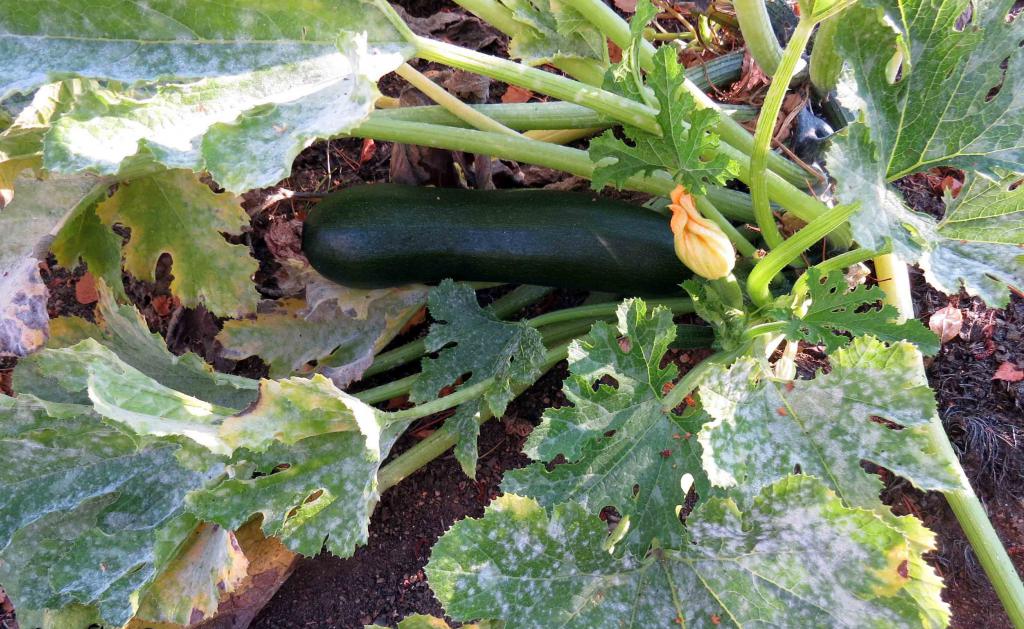
Fighting the disease is not easy, so it's best not to let her into the garden. The basic rule is that organic plant debris must be carefully removed and disposed of. If the crops were previously infected with fungi, then these residues should not fall on the composter under any circumstances. Sowing should also be weeded out systematically and careful not to be sprinkled with a sprinkler system. The drip system is better, the plant leaves should not be soaked. A good way to avoid fungal infections is to water with horsetail or onion leaf manure. Means for preventive spraying against downy mildew - indispensable Avgust Pure flowers.
If the crop is affected by powdery mildew, spraying with plant protection products is necessary. And here, too, the correct drug must be selected for a specific species, and not for a pathogen.
Plant protection chemicals
Processing should begin with the first spots on the leaves and petioles and continue until harvest. For chemical protection against powdery mildew, systemic preparations containing bupirimate can be used. It is also worth considering contact and systemic drugs containing pyraclostrobin and boscalid. Such preparations can be used as a preventive measure or after the first symptoms of the disease are detected, but no later than 14 days before harvest. From the 10 leaf phase to the beginning of the phase when the roots begin to expand, a maximum of two treatments can be performed.
Tiovit Jet
Fungicidal remedy for various diseases, powdery mildew, as well as for ticks. It combines the properties of fungicide, acaricide and micronutrient fertilizer. The drug was developed jointly with a Swiss company and is highly effective.
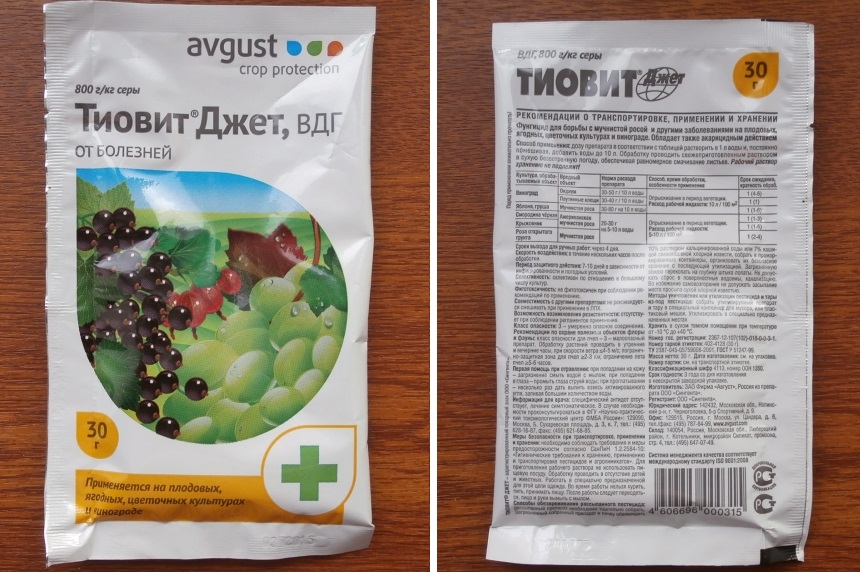
weight - 30 g;
country of origin - Russia;
brand - AVGUST .;
preparative form - water-dispersed granules .;
price - 28 rubles.
- affordable price;
- convenient packaging;
- excellent adhesion;
- good contact action;
- high efficiency;
- the duration of the drug is up to 10 days;
- not phytotoxic;
- effective in the fight against powdery mildew, spider mites;
- suitable for fruit trees (apple, pear), shrubs (currants, gooseberries), roses and grapes;
- possesses fungicidal and acaricidal action;
- simple application.
- not compatible with agricultural chemicals;
- prohibited to use during flowering plants;
- quickly washed off by precipitation.
Dew Bottle
A fungicide against powdery mildew is used to protect, prevent and treat crops. Recommended for protection against diseases of berries (gooseberries, raspberries, currants, honeysuckle). An effective remedy for gray rot, anthracnose.
volume - 10 ml;
packing - on a blister;
preparative form - liquid;
price - 66 rubles;
country of origin - Russia.
- affordable price;
- simple application;
- efficiency;
- moderate consumption of the drug;
- good contact action.
- ineffective in cool and damp weather;
- work exclusively with precautions.
Topaz
Fungicidal preparation for powdery mildew and rust. Possesses preventive, curative and eradicating actions. Stops the growth of the mycelium of the pathogen of powdery mildew in 2-3 hours after treatment. It is quickly absorbed by plants, which reduces the risk of being washed away by rain.
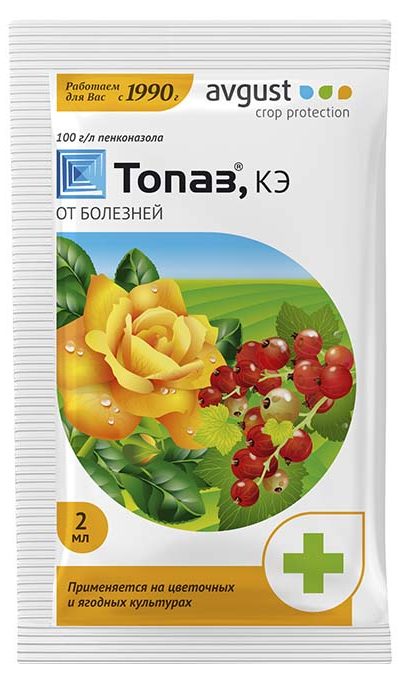
volume - 10 ml;
packing - on a blister;
preparative form - liquid;
brand - AVGUST;
country of origin Russia;
price - 125 rubles.
- efficiency;
- moderate consumption;
- prevention and treatment;
- helps to slow down the growth of the mycelium of the pathogen of powdery mildew;
- well absorbed;
- effective in the fight against powdery mildew, spider mites;
- suitable for fruit trees (apple, pear), shrubs (currants, gooseberries), roses and grapes;
- has good adhesion, which reduces the risk of being washed off by rain.
- a little expensive.
Avgust Pure Blossom
Systemic fungicide for powdery mildew. The preparation is in the form of a spray, ready to use, convenient and effective against gray mold and stains.
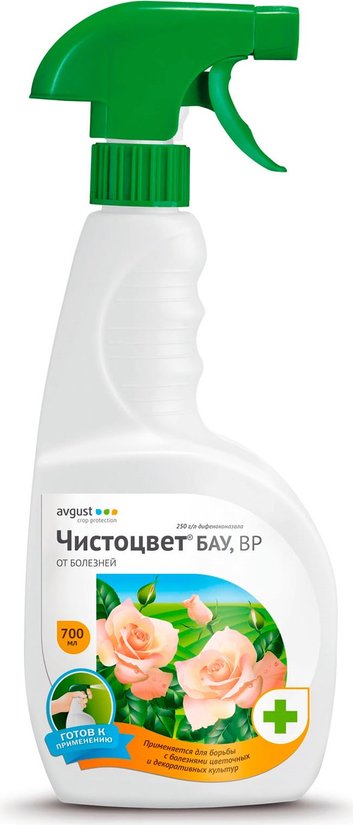
volume - 700 ml;
brand - AVGUST;
country of origin - Russia;
price - 309 rubles;
preparative form - liquid (spray).
- convenience and ease of use;
- protection from 4 to 5 weeks;
- not toxic to plants;
- the product is resistant to precipitation after two hours after treatment;
- deeply penetrates within 2-4 hours from the moment of application;
- suitable for flowers, ornamental plants, fruit trees;
- the drug is ready for use.
- not.
Double garden protection
Avgust Topaz + Biotlin complex remedy of a domestic manufacturer against powdery mildew and aphids is intended to protect berry bushes (black currant and gooseberry).
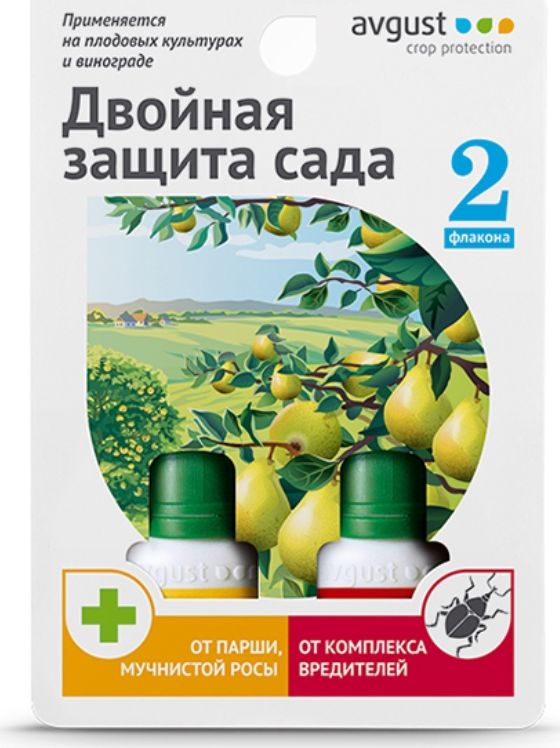
volume - bottle 10 ml + 9 ml;
preparative form - liquid;
country of origin - Russia;
price - 170 rubles.
- affordable price;
- moderate consumption;
- convenient packaging;
- good adhesion and contact action.
- not.
Green Belt Forecast
A systemic remedy for powdery mildew, which has a protective effect against powdery mildew.
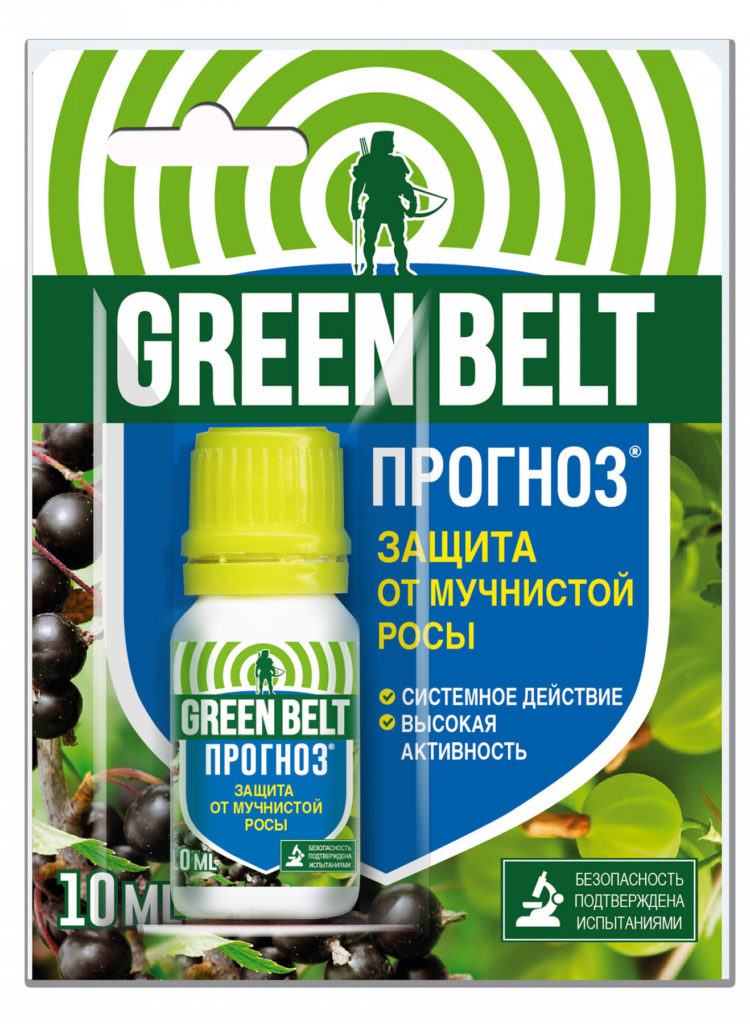
Volume - 10 ml;
Preparative form - liquid;
Country of origin - Russia;
Price - 109 rubles.
- affordable price;
- convenient packaging;
- high efficiency;
- suitable for different cultures;
- the drug is active for 3-5 weeks.
- the drug is ineffective in cool weather and in conditions of high humidity.
Biologicals
Fitosporin-M OZhZ
Biological product for plant protection against diseases. A universal and effective remedy suitable for the treatment and prevention of diseases (fungal and bacterial). In addition, the tool shows good results in the fight against late blight, root rot, scab, black leg, rust and others.
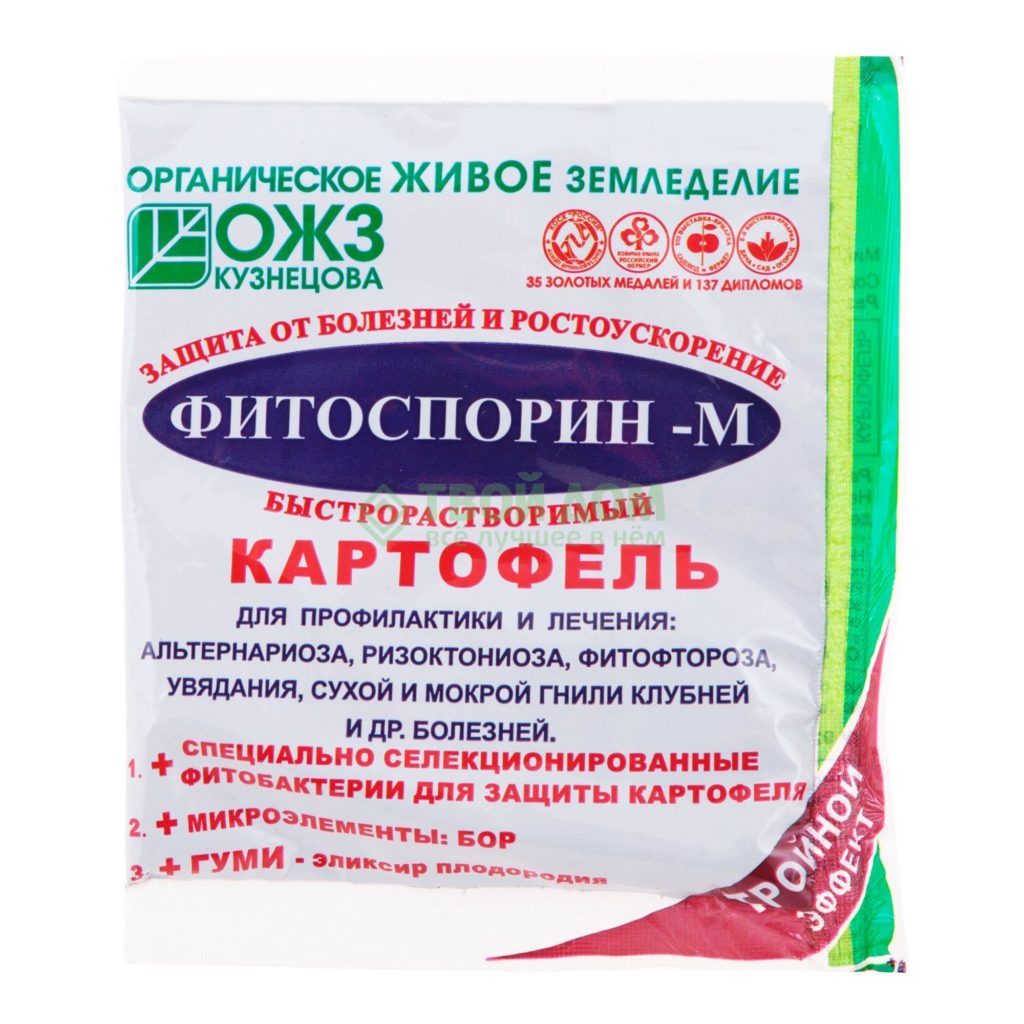
Weight - 10 g;
Packaging - package;
Price - 20 rubles;
Country of origin - Russia.
- price;
- ease of use;
- versatility;
- recommended for prevention and treatment;
- the drug is not phytotoxic;
- the product is enhanced with the elixir of fertility;
- products can be eaten on the day of processing.
- organic preparation;
- low hazard for bees.
- not.
Rapsolin
Phytopreparation for garden and indoor crops, has a protective effect against diseases and pests. The product contains natural rapeseed oils, it is environmentally friendly and non-phytotoxic.
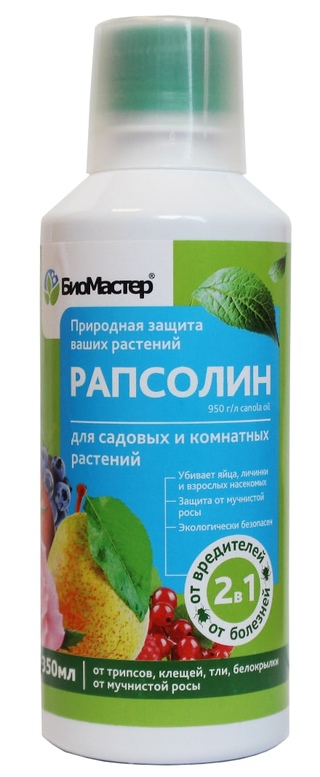
Volume - 350 ml;
Packing - a bottle made of dense plastic;
Preparative form - liquid;
Country of origin - Russia;
Price - 273 rubles.
- versatility;
- high efficiency;
- based on natural ingredients;
- suppresses the development and growth of pathogens;
- protects garden and indoor crops;
- oily consistency of the product;
- evenly covers the surface;
- contributes to the death of pests.
- not.
Conclusion

A beautiful garden, a summer cottage is the dream of every gardener and gardener. Growing delicious fruits and vegetables with your own hands is a goal that you need to strive for. Tips and tricks in the article on the choice of chemicals and biologicals will help you achieve your goal, and correctly selected drugs will help you effectively fight diseases and pests. Delicious summer and good harvest !!!
new entries
Categories
Useful
Popular articles
-

Top rating of the best and inexpensive scooters up to 50 cubic meters in 2020
Views: 97661 -

Rating of the best materials for noise insulation for an apartment in 2020
Views: 95022 -

Rating of cheap analogues of expensive drugs for flu and colds for 2020
Views: 91751 -

The best men's running shoes in 2020
Views: 87681 -

Top ranking of the best smartwatches 2020 - price-quality
Views: 85091 -

Best Complex Vitamins in 2020
Views: 84801 -

The best dye for gray hair - 2020 top ranking
Views: 82406 -

Rating of the best wood paints for interior use in 2020
Views: 77202 -

Ranking of the best action cameras from China in 2020
Views: 75269 -

Rating of the best spinning reels in 2020
Views: 74827 -

The most effective calcium supplements for adults and children in 2020
Views: 72463 -

Top rating of the best means for male potency in 2020 with a description
Views: 68296
